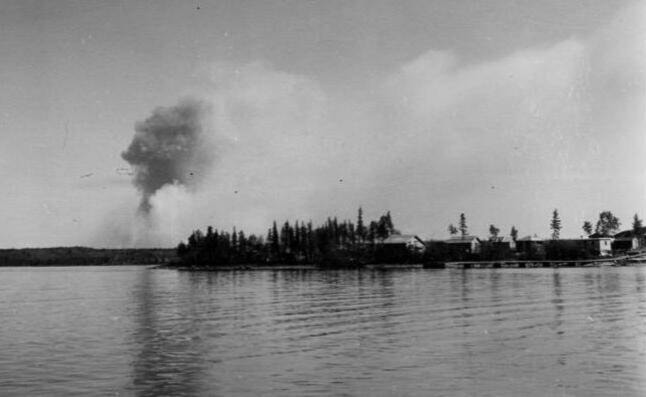Wildfires are not new to Yellowknife. The city experienced bad fire seasons in recent memory to many of us: 1998, and of course, the summer of smoke, 2014. This past summer, 2023, proved to be a very memorable one too. But Yellowknifers have co-existed with fire since the beginning of the community.
Bush fires plagued Yellowknife during the height of the gold rush in the late 1930s. In July 1936, a fire was started near Duck Lake on the east side of Yellowknife Bay. Fanned by strong south winds, the fire crept up the bay towards Burwash Point, where the Burwash gold mine was operating. The miners abandoned their gold workings and battled the flames with pick axe and shovel to clear a fire break.
The fire also threatened the nearby Dene village of Dettah, where all the men of the community had left to accept Treaty money in Fort Resolution. Women of the village kept regular vigil to stamp out embers as they fell amongst their lodges and log cabins. (Not surprising that Dettah means ‘burnt point’). A shift of wind ultimately saved the day.
In 1938, the town of Yellowknife was booming when a smoky haze blew in from the southwest. A massive forest fire was burning up from the North Arm of Great Slave Lake towards the Con and Negus gold mines. Dry weather and high winds fanned the flames. All of the land around Kam Lake was a blaze.
The miners saved their camp, but the next summer, 1939, new hot spots popped up around today’s Tin Can Hill where a telephone line strung between the mines and Old Town was at great peril. At Peace River Flats, a smoldering fire encroached towards residences and burned down a cabin before a group of citizens responded to save Old Town.
Debate raged for years about the root cause of wildfires. Some believed it was the result of careless campers and hunters failing to extinguish their campfires. Others blamed prospectors for igniting the bush to eliminate moss and overburden to make their job of searching for minerals easier. One of the more interesting theories suggested pilots were throwing cigarette butts from their floatplanes.
Yellowknife was spared of wildfire in the 1930s and again in 1945 when fires raged once more throughout the region. It is no surprise that fires have returned in 2023. Our forests have been allowed to grow thick with deadfall, as there has not been a fire in this area in 75 to 85 years.
—This article was contributed by the Yellowknife Historical Society. Find their website here: https://www.yellowknifehistory.com/
